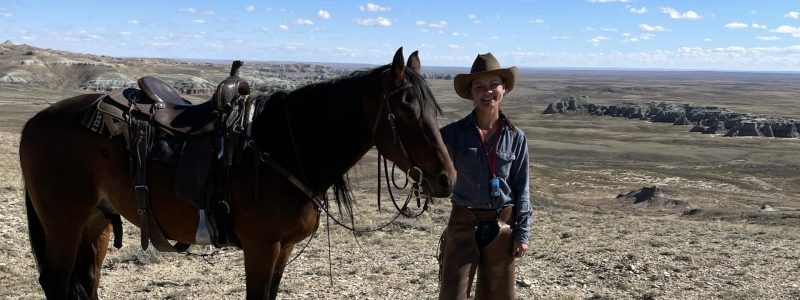From sprawling desertscapes to vast, forested ranges, the public lands that cover more than half of Wyoming are incredibly varied — and wildly important. Public lands support thriving wildlife populations, host incredible opportunities for recreation and solitude, and are home to uncountable cultural resources.
Advocating conservation of the extensive and irreplaceable public lands in Wyoming is a core part of what we do here at WOC. That’s why we’re so excited to welcome Gabby Yates, our new public lands program manager, who will be largely focused on protecting Wyoming’s remarkable lands.
We sat down with Gabby to talk about cultivating a love for landscapes, her background, and what she’s most excited about as she moves into her new role.
Can you share a little about your background?
I grew up in central New York, outside of Syracuse. After high school, I attended Colgate University and earned a degree in Geography. I didn’t want to jump straight into a 9–5 job after graduating, so I applied to horsepacking jobs — and soon found myself stepping off a plane in Wyoming. From that first week, I knew I wanted to make the state home.
During that first week, what was it about Wyoming that drew you in?
I started to feel how the openness of the landscapes affects people, even if I couldn’t yet put that into words. By “openness,” I mean both the beauty and vastness of the Wyoming skyline as well as the access folks have to it. I remember leaving the Riverton airport that first day and driving south. My new colleague pointed to the snow-capped Winds River Range and said, “You’ll be living up there.” The more folks I met here, the more I saw how a relationship with the land carries over into all aspects of life, and how it was becoming intrinsic to my own life.
Was there a particular moment or experience that sparked your interest in public lands advocacy?
There wasn’t a specific moment, but rather the realization that public lands are the reason I love Wyoming. I’ve spent the better part of the last six years working on, living in, and exploring Wyoming public lands — from caring for cattle in the Red Desert to leading horsepacking trips in the Absarokas and Wind River Mountains. Public lands management here is a sea change from the way the landscape is managed where I grew up.
That’s interesting — can you elaborate on that? What makes public lands management in Wyoming so unique?
Half of Wyoming is public land. And that’s public land that is fairly well dispersed throughout the state, with large tracts of intact, wild ecosystems, and working landscapes, too. That doesn’t exist in most of the world, and it means that living here, people can and often do have a much closer, albeit nuanced, relationship to so much of their “backyard.” It also means that they have a voice in how that landscape is managed, and a responsibility to use that voice.
As a horsepacking guide, you had the chance to share wild lands with people who aren’t at all familiar with them. What was it like to watch them form their own relationships with the land?
It is easy for people to be awed by the beauty of Wyoming’s mountains and wildlife, and it never gets old to share something you love with other folks. What’s really fun, though, is just what you mentioned — people starting to form relationships with the land. You can see it in the conversations you have while riding, from discussing the nuances of wildlife management, land use, or local history, to simply learning to name wildflowers, to feeling more and more oriented to the landscape. I think having a taste for the complexity of these wild lands helps build a foundation so that when folks go home, they don’t just remember a pretty place, or how cold it was at night, for example.
What excites you most about joining WOC as the public lands program manager?
There are so many opinions out there about what happens on public lands, but that means that so many people care about public lands. I am most excited to have conversations and learn from folks that are passionate about these places, to hopefully inch toward common ground, so that future generations can experience the landscapes and wildlife that we enjoy today.
What are some of the things you’re bringing with you from previous roles, as you begin this one?
The time I’ve spent on the ground in public lands through ranching and outfitting has shaped my understanding of public lands and the relationship that folks have with these landscapes. I think that puts me in a place to better find common ground and solutions. Likewise, my background in human geography has trained me to look for ways to find and address nuance in human-environmental relationships. That’s a necessity in looking toward finding solutions for Wyoming’s public lands.
When you’re not in the office, what do you enjoy doing in your free time?
I enjoy exploring new places on horseback, hiking with my dog, hunting, reading, and trying out New York Times recipes. I am planning on planting a garden next year, and am very excited about that prospect.
Do you have a favorite outdoor activity or place to visit on public lands?
I’d say camping somewhere up high in the Shoshone National Forest, drinking coffee, ideally on a frosty morning in early fall.

